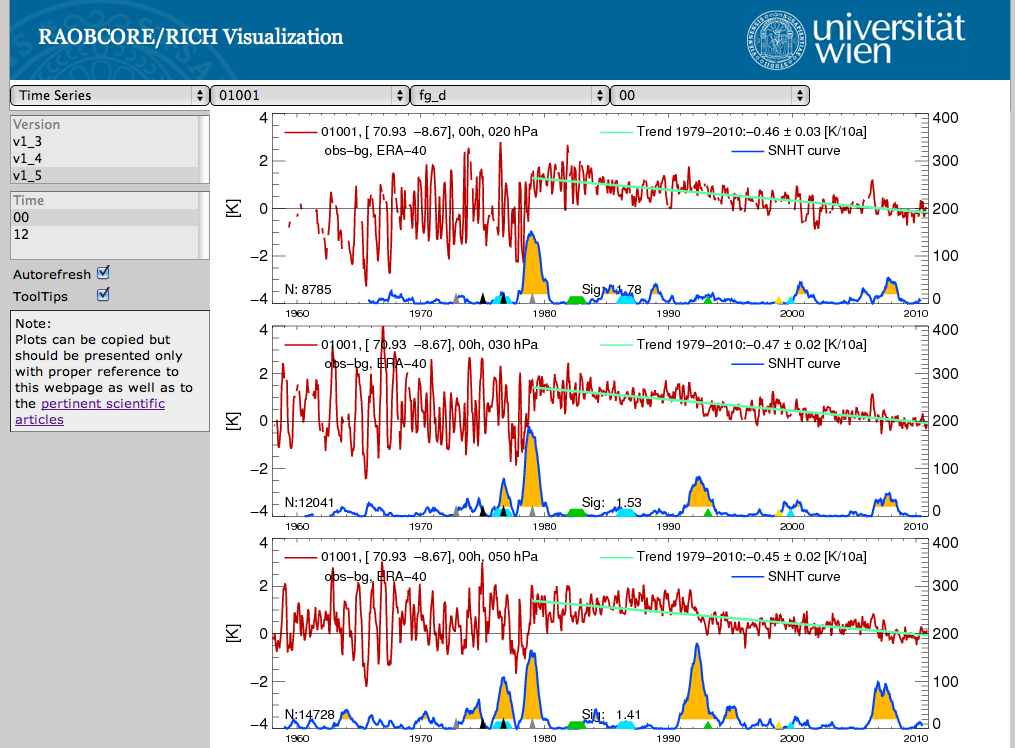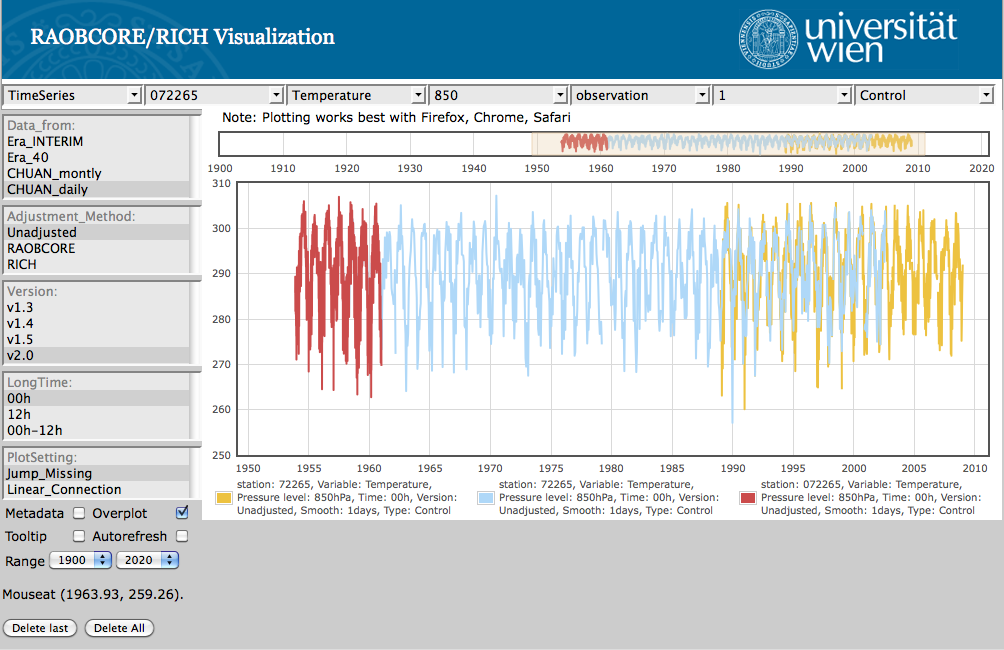The International Surface Pressure Databank (ISPD, Cram et al. 2015) is the world's largest collection of pressure observations. It spans 1722-2015. It has been developed by extracting observations from established international archives of meteorological variables and by combining these with observations made available through additional international cooperation with data recovery facilitated by the Atmospheric Circulation Reconstructions over the Earth (ACRE) Initiative and the other contributing organizations. The ISPD is assembled under the auspices of the GCOS Working Group on Surface Pressure and the GCOS/WCRP Working Group on Observational Data Sets for Reanalysis by NOAA Earth System Research Laboratory (ESRL), NOAA's National Centers for Environmental Information (NCEI), and the University of Colorado's Cooperative Institute for Research in Environmental Sciences (CIRES).
The ISPD consists of three components: station observations, marine observations, and tropical cyclone best track pressure reports.
The station component is a blend of many national and international collections, with the largest contributor being surface and sea level pressure observations from the International Surface Database (ISD, Lott et al., 2008). Procedures for blending the station component are described at Yin et al. (2008).
The marine component consists of the available version of the International Comprehensive Ocean Atmosphere Data Set (ICOADS, Worley et al., 2005). In some ISPD versions, ICOADS Auxiliary data, ACRE recovered expeditions, and Oldweather.org data are also used.
The tropical cyclone component comes mainly from the available version of the International Best Track Archive for Climate Stewardship (IBTrACS, Knapp et al., 2010). In the absence of a central pressure estimate, IBTrACS wind estimates are converted to pressure using an empirical gradient wind equation (Compo et al. 2011).
To submit station observations, please submit your observations to NOAA's National Center for Environmental Information via Xungang.Yin@noaa.gov using the ASCII exchange format v1.0.
Version 5 (1755-2012)
Version 5 of the International Surface Pressure Databank is currently being assembled.
Additional guidelines for station data submission are under development.
Version 4 (1836-2015)
Version 4 of the ISPD is available courtesy of the Research Data Archive of the Computational and Information Systems Laboratory (CISL) at the National Center for Atmospheric Research (NCAR) from http://rda.ucar.edu/datasets/ds132.2/. Subsetting tools are available to retrieve the data in ASCII format. Documentation for the HDF5 format is provided at https://rda.ucar.edu/datasets/ds132.2/index.html#!docs. Users can also browse an interactive map displaying observation locations by type, date, and region using the NCAR Interactive Station Viewer at https://rda.ucar.edu/datasets/ds132.2/index.html#wstationViewer.
NOAA's National Centers for Environmental Information has merged the station component using the ASCII exchange format v1.1. The marine component comes from ICOADS version 3+, with enhancements to ICOADS version 3 from ACRE, Oldweather.org and Weather Detective courtesy of P. Brohan of the UK Met Office. The tropical cyclone component comes mainly from IBTrACS V03r10. See Slivinski et al. 2019 for details.
Maps showing the location of stations in a selected year can be browsed at https://psl.noaa.gov/data/ISPD/.
Maps showing the location of observations used in 20CRV3 in a selected year can be browsed at https://psl.noaa.gov/data/20CRv3_ISPD_obscounts/
Maps showing the location of all available, rejected, and assimilated observations used in 20CRV3 in a selected month can be browsed at https://psl.noaa.gov/data/20CRv3_ISPD_obscounts_bymonth/
The V4 list of stations, including location and period of coverage, and their history is a text file that can be imported into Excel or read into other programs using this format.
DOI: 10.5065/9EYR-TY90
Citation: Compo, G. P., et al. 2019. The International Surface Pressure Databank version 4. Research Data Archive at the National Center for Atmospheric Research, Computational and Information Systems Laboratory. https://doi.org/10.5065/9eyr-ty90. Accessed § dd mmm yyyy.
§Please fill in the "Accessed" date with the day, month, and year (e.g. - 5 Aug 2011) you last accessed the data from the NCAR Research Data Archive.
Version 3 (1755-2011)
Version 3 of the ISPD is available courtesy of the Research Data Archive of the Computational and Information Systems Laboratory (CISL) at the National Center for Atmospheric Research (NCAR) from http://rda.ucar.edu/datasets/ds132.1/. NCAR also has documentation on the HDF5 Format for International Surface Pressure Data Bank v10.11.
NOAA's National Climatic Data Center has merged the station component using the ASCII exchange format v1.1. The marine component comes from ICOADS version 2.5. The tropical cyclone component comes from IBTrACS V03r03. ISPDv3 is being used in the century long reanalysis ERA-20C generated by ERA-CLIM, by the century long reanalysis being generated by JMA/MRI, and by NOAA/CIRES in 20CR version 2c.
Maps showing the location of stations in a selected year can be browsed at http://www.esrl.noaa.gov/psd/data/ISPD/v3.0/
The V3 list of stations, including location and period of coverage, and their history is a text file that can be imported into Excel or read into other programs using this format.
DOI: 10.5065/D6D50K29
Citation: Compo, G. P., et al. 2015. The International Surface Pressure Databank version 3. Research Data Archive at the National Center for Atmospheric Research, Computational and Information Systems Laboratory. http://dx.doi.org/10.5065/D6D50K29. Accessed § dd mmm yyyy.
§Please fill in the "Accessed" date with the day, month, and year (e.g. - 5 Aug 2011) you last accessed the data from the NCAR Research Data Archive.
Version 2 (1768-2012)
Version 2 of the ISPD can be obtained courtesy of Data Engineering and Curation Section of the Computational and Information Systems Laboratory at the National Center for Atmospheric Research from http://rda.ucar.edu/datasets/ds132.0/. NCAR also has documentation on the HDF5 Format for International Surface Pressure Data Bank v10.11.
For the period 1871-2011, Version 2 includes metadata information from the quality control system of the 20th Century Reanalysis Project. These so-called "feedback" records include the difference between the final analysis and each observation, the estimated uncertainty in the observation, and other quality information.
See Compo et al. (2011) and Cram et al. (2015) for a more detailed description.
Maps showing the location of stations in a selected year can be browsed at http://www.esrl.noaa.gov/psd/data/ISPD/v2.0/.
The V2 list of stations, including location and period of coverage, and their history is a text file that can be imported into Excel or read into other programs using this format.
DOI:10.5065/D6SQ8XDW
Citation: Compo, G. P., et al. 2010. International Surface Pressure Databank (ISPDv2). Research Data Archive at the National Center for Atmospheric Research, Computational and Information Systems Laboratory. http://dx.doi.org/10.5065/D6SQ8XDW. Accessed§ dd mmm yyyy.
§Please fill in the "Accessed" date with the day, month, and year (e.g. - 5 Aug 2011) you last accessed the data from the NCAR Research Data Archive.
Future Additions
At http://badc.nerc.ac.uk/browse/badc/corral/images/metobs there any many useful links to information about known observations and their recovery status. The site has links to scanned images of hard copy meteorological observations held by the National Meteorological Archive of the UK Met Office that have been imaged to date. It also has an EXCEL file containing the status of all of the historical weather data (whether hard copy, scanned or digitised) being recovered, imaged, and digitised by the international ACRE community and international organisations projects and researchers linked to the Initiative for the ISPD. Additionally, the site has annual global maps showing terrestrial weather data distribution and their status.
The International Surface Pressure Databank would like to thank the contributing organizations and make many grateful acknowledgments. Support for the compilation of the ISPD is provided by the National Oceanic and Atmospheric Administration Climate Program Office and SwissRe.
The 20th Century Reanalysis Project used resources of the National Energy Research Scientific Computing Center and of the Oak Ridge Leadership Computing Facility at Oak Ridge National Laboratory, which are supported by the Office of Science of the U.S. Department of Energy under Contract No. DE-AC02-05CH11231 and Contract No. DE-AC05-00OR22725, respectively. Support for the 20th Century Reanalysis Project dataset is provided by the U.S. Department of Energy, Office of Science Innovative and Novel Computational Impact on Theory and Experiment (DOE INCITE) program, and Office of Biological and Environmental Research (BER), by the National Oceanic and Atmospheric Administration Climate Program Office, and by NOAA Earth System Research Laboratory Physical Sciences Division.

References:
Compo, G.P., J.S. Whitaker, P.D. Sardeshmukh, N. Matsui, R.J. Allan, X. Yin, B.E. Gleason, R.S. Vose, G. Rutledge, P. Bessemoulin, S. Brönnimann, M. Brunet, R.I. Crouthamel, A.N. Grant, P.Y. Groisman, P.D. Jones, M. Kruk, A.C. Kruger, G.J. Marshall, M. Maugeri, H.Y. Mok, Ø. Nordli, T.F. Ross, R.M. Trigo, X.L. Wang, S.D. Woodruff, and S.J. Worley, 2011: The Twentieth Century Reanalysis Project. Quarterly J. Roy. Meteorol. Soc., 137, 1-28. DOI: 10.1002/qj.776.
Cram, T.A., G. P. Compo, X. Yin, R. J. Allan, C. McColl, R. S. Vose, J.S. Whitaker, N. Matsui, L. Ashcroft, R. Auchmann, P. Bessemoulin, T. Brandsma, P. Brohan, M. Brunet, J. Comeaux, R. Crouthamel, B. E. Gleason, Jr., P. Y. Groisman, H. Hersbach, P. D. Jones, T. Jonsson, S. Jourdain, G. Kelly, K. R. Knapp, A. Kruger, H. Kubota, G. Lentini, A. Lorrey, N. Lott, S. J. Lubker, J. Luterbacher, G. J. Marshall, M. Maugeri, C. J. Mock, H. Y. Mok, O. Nordli, M. J. Rodwell, T. F. Ross, D. Schuster, L. Srnec, M. A. Valente, Z. Vizi, X. L. Wang, N. Westcott, J. S. Woollen, S. J. Worley, 2015: The International Surface Pressure Databank version 2. Geoscience Data Journal, 2, 31-46. DOI: 10.1002/gdj3.25.
Knapp KR, Kruk MC, Levinson DH, Diamond HJ, Neumann CJ, 2010: The International Best Track Archive for Climate Stewardship (IBTrACS): Unifying tropical cyclone best track data. Bull. Amer. Meteorol. Soc.91: 363–376. DOI: 10.1175/2009BAMS2755.1.
Lott N, Vose R, Del Greco SA, Ross TF, Worley S, Comeaux J. 2008. ‘The Integrated Surface Database: Partnerships and progress.’ In Proceedings of 88th AMS Annual Meeting, 20–25 January 2008, New Orleans, Louisiana, combined preprints (CD-ROM), Amer. Meteorol. Soc: Boston, MA. Available from http://www1.ncdc.noaa.gov/pub/data/ish/ams-isd-jan08.pdf.
McColl, C., X. Yin, G. Compo, R. Allan, R. Vose, S. Woodruff, K. Knapp, and T. Cram, 2011: Assembling the International Surface Pressure Databank. World Climate Resarch Programme Open Science Conference, Denver, USA, 24 October. Poster link.
Slivinski, L. C., Compo, G. P., Whitaker, J. S., Sardeshmukh, P. D., Giese, B. S., McColl, C., Allan, R., Yin, X., Vose, R., Titchner, H., Kennedy, J., Spencer, L. J., Ashcroft, L., Brönnimann, S., Brunet, M., Camuffo, D., Cornes, R., Cram, T. A., Crouthamel, R., Domínguez‐Castro, F., Freeman, J. E., Gergis, J., Hawkins, E., Jones, P. D., Jourdain, S., Kaplan, A., Kubota, H., Le Blancq, F., Lee, T., Lorrey, A., Luterbacher, J., Maugeri, M., Mock, C. J., Moore, G. K., Przybylak, R., Pudmenzky, C., Reason, C., Slonosky, V. C., Smith, C., Tinz, B., Trewin, B., Valente, M. A., Wang, X. L., Wilkinson, C., Wood, K. and Wyszyński, P. (2019), Towards a more reliable historical reanalysis: Improvements for version 3 of the Twentieth Century Reanalysis system. Q J R Meteorol Soc. (accepted) doi:10.1002/qj.3598.
Worley SJ, Woodruff SD, Reynolds RW, Lubker SJ, Lott N. 2005. ICOADS release 2.1 data and products. Int. J. Climatol.25: 823–842. DOI: 10.1002/joc.1166.
Yin X, Gleason BE, Compo GP, Matsui N, Vose RS, 2008: The International Surface Pressure Databank (ISPD) land component version 2.2. National Climatic Data Center, Asheville, NC. Available from ftp://ftp.ncdc.noaa.gov/pub/data/ispd/doc/ISPD2_2.pdf or from this site.







Re: Surface data quality control issues
Ie. that the data in one station ID is repeated under another station ID somewhere. e.g if merging of stations for some reason didn't happen correctly.
Robert